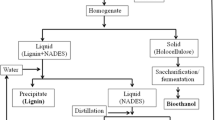Abstract
A pretreatment of lignocellulosic materials with sodium hypochlorite-hypochlorous acid at controlled pH (between 7 and 9) considerably increases the accessibility of the cellulosic part of the substrate to chemical and biochemical reactants. As a consequence, the yield and rate of the enzymatic hydrolysis to glucose is largely in creased. Wheat straw and spruce sawdust have been investigated. The increase in accessibility is assigned to degradation and (or) de tachment of the lignin network. The loss in cellulose and hemicellulose is not important, lignin being preferentially degraded under carefully controlled pH conditions. When applied to pure cel lulose, the pretreatment decreases the yield of enzymatic hydrolysis; in the absence of lignin, oxidation of the anhydroglucose units is im portant and results in the inhibition of the enzymatic hydrolysis.
Similar content being viewed by others
References
Wilke, C. R., Maiorella, B., Sciamanna, A., Tangnu, K., Wiley, D., and Wong, H.,Enzymatic Hydrolysis of Cellulose—Theory and Applications, Noyes Data Corporation. Park Ridge, NJ, 1983.
David, C., and Thiry, Ph.,J. Appl. Poly. Sci. 27, 2395 (1982).
David, C., Thiry, Ph., and Fornasier, R., to be published.
David, C., Thiry, Ph., and Fornasier, R., Demande de Brevet Européen 83200306-5 (2.3.83): Procédé de traitement de matériaux ligno-cellulosiques;CA 99 (26), 214393y.
David, C., Daro, A., and Monnoye, D.,Eur. Poly. J. 16, 1159 (1980).
The ratio HC1O/(HC1O + ClO s-) as a function of pH is given in Table 1.
David, C., and Thiry, Ph.,Eur. Poly. J. 17, 957 (1981).
David, C., Fornasier, R., Greindl-Fallon, C., and Vanlautem, N.,Biotech. Bioeng. (in press).
McBurney, L. F., inCellulose and Cellulose Derivatives, vol. V, part I, Interscience, 1954.
Lewin, M., and Epstein, J. A.,J. Poly. Sci. 58, 1023 (1962).
Sarkanen, K. V., and Ludwig, C. H., eds.Lignins Wiley, NY, 1971.
David, C., and Fornasier, R.,Macromolecules (in press).
Author information
Authors and Affiliations
Rights and permissions
About this article
Cite this article
David, C., Fornasier, R. & Thiry, P. Utilization of waste cellulose. Appl Biochem Biotechnol 11, 351–365 (1985). https://doi.org/10.1007/BF02798669
Received:
Accepted:
Issue Date:
DOI: https://doi.org/10.1007/BF02798669
Index Entries
- Pretreatment, by sodium hypochlorite in the enzymatic hydrolysis of cellulose wood and straw byTrichoderma viride cellulases
- sodium hypochlorite, pretreatment for the enzymatic hydrolysis of cellulose, wood, and straw byTrichoderma viride cellulases
- Cellulose, wood straw, pretreatment by sodium hypochlorite for the enzymatic hydrolysis byTrichoderma viride cellulases
- Enzymatic hydrolysis, byTrichoderma viride cellulases of cellulose, wood, and straw
- lignocellulose materials, enzymatic hydrolysis of
- Trichoderma viride, in enzymatic hydrolysis of lignocellulose materials




